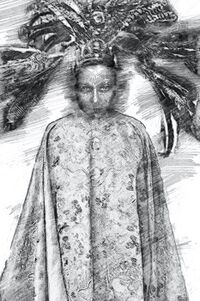Portal:Astyria/Article: Difference between revisions
No edit summary |
No edit summary |
||
| Line 1: | Line 1: | ||
<div style="float:right;margin:0.5em 0.9em 0.4em 0;">[[File:Ratukunti.jpg|200px]]</div>In [[Hindia Belanda|Hindia Belandan]] myth, the '''Ratukunti''' is a demon whose origins lie in prehistoric Hindia Belandan cultures. The Ratukunti is said to be the leader of the [[Boentianak|boentianaks]], who are vengeful vampiric beings transformed from the spirits of women who died during childbirth. Whilst the boentianaks were human, the Ratukunti is not but only takes on a human form when making an apparition in order to lure unsuspecting people who may be wandering alone on certain nights of the year. When taking a human form, the Ratukunti is described as a lady with facial tattoos, suggesting Austronesian origins, wearing a long robe often associated with the [[Anjani Empire|Andjanian nobility]] and an elaborate headgear with palm fronds. The prevalence of the Ratukunti in virtually every folklore of all islands in Hindia Belanda except the island of [[Papoea]] suggests that it was spread by Andjanians during the expansionist period of the [[Anjani Empire|Andjani Empire]].<ref>Ladjoeng 2007, p. 133.</ref> ('''[[ | <div style="float:right;margin:0.5em 0.9em 0.4em 0;">[[File:Ratukunti.jpg|200px]]</div>In [[Hindia Belanda|Hindia Belandan]] myth, the '''Ratukunti''' is a demon whose origins lie in prehistoric Hindia Belandan cultures. The Ratukunti is said to be the leader of the [[Boentianak|boentianaks]], who are vengeful vampiric beings transformed from the spirits of women who died during childbirth. Whilst the boentianaks were human, the Ratukunti is not but only takes on a human form when making an apparition in order to lure unsuspecting people who may be wandering alone on certain nights of the year. When taking a human form, the Ratukunti is described as a lady with facial tattoos, suggesting Austronesian origins, wearing a long robe often associated with the [[Anjani Empire|Andjanian nobility]] and an elaborate headgear with palm fronds. The prevalence of the Ratukunti in virtually every folklore of all islands in Hindia Belanda except the island of [[Papoea]] suggests that it was spread by Andjanians during the expansionist period of the [[Anjani Empire|Andjani Empire]].<ref>Ladjoeng 2007, p. 133.</ref> ('''[[Ratukunti|See more...]]''') | ||
<div align="right"> | <div align="right"> | ||
'''<span class="plainlinks">[https://iiwiki.us/mediawiki/index.php?title=Portal_talk:Astyria/Article&action=edit Suggest an Article]</span>'''</div><noinclude> | '''<span class="plainlinks">[https://iiwiki.us/mediawiki/index.php?title=Portal_talk:Astyria/Article&action=edit Suggest an Article]</span>'''</div><noinclude> | ||
Revision as of 19:58, 2 April 2021
In Hindia Belandan myth, the Ratukunti is a demon whose origins lie in prehistoric Hindia Belandan cultures. The Ratukunti is said to be the leader of the boentianaks, who are vengeful vampiric beings transformed from the spirits of women who died during childbirth. Whilst the boentianaks were human, the Ratukunti is not but only takes on a human form when making an apparition in order to lure unsuspecting people who may be wandering alone on certain nights of the year. When taking a human form, the Ratukunti is described as a lady with facial tattoos, suggesting Austronesian origins, wearing a long robe often associated with the Andjanian nobility and an elaborate headgear with palm fronds. The prevalence of the Ratukunti in virtually every folklore of all islands in Hindia Belanda except the island of Papoea suggests that it was spread by Andjanians during the expansionist period of the Andjani Empire.[1] (See more...)
- ↑ Ladjoeng 2007, p. 133.
